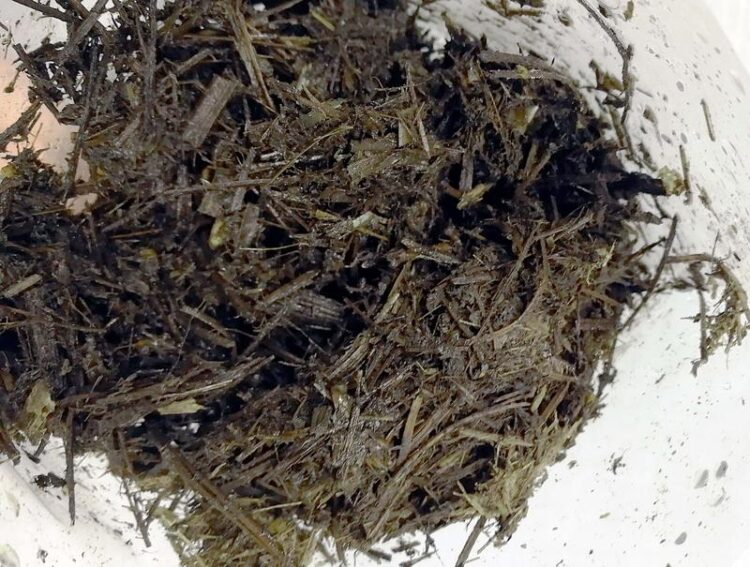Furniture from the biogas plant

Unwashed biogas digestate
(c) DITF
The Hallertau is Germany’s largest hop-growing region. During harvesting, hop bine chaff is left over, which is converted into environmentally friendly bio natural gas on site in a biogas plant. But that is not the end of the utilization chain for this fiber plant. Researchers at the German Institutes of Textile and Fiber Research Denkendorf (DITF) have used the plant-containing biogas digestate to produce a composite material that can be used to make furniture.
Laminates are in great demand in the furniture industry because they can be designed very flexibly. The composite material made from biogas digestate developed at the DITF with their project partners is a particularly sustainable variant. To produce it, these plant-based residues are first cleaned in an environmentally-friendly way. From this mass, the DITF and Reutlingen University have developed a wet laid nonwoven that is pressed together with a bio-based resin system to form a composite material. It is load-bearing and can be processed in a variety of ways. The project group has created an initial demonstrator from the material.
The project is an example of successful circular economy and value creation. Using biogas digestate as an industrial raw material is an environmentally-friendly alternative to their previous use as fertilizer, which increases nitrate pollution of the soil and is also significantly restricted by new regulations. Chemical additives are deliberately avoided in the production process, and if offcuts from the textile industry are also used in the design of the furniture, this results not only in unusual designs but also in further added value for the environment.
The research project was funded as part of the Central Innovation Program for SMEs (ZIM). The project partners were Hopfenpower GmbH, Novis GmbH and the joinery Nuding.
Wissenschaftliche Ansprechpartner:
Prof. Dr.-Ing. Markus Milwich
Deputy Head of Competence Center Polymers & Fiber Composites
Head of Fiber Composite Technology
T +49 (0)711 93 40-164
E markus.milwich@ditf.de
Media Contact
All latest news from the category: Ecology, The Environment and Conservation
This complex theme deals primarily with interactions between organisms and the environmental factors that impact them, but to a greater extent between individual inanimate environmental factors.
innovations-report offers informative reports and articles on topics such as climate protection, landscape conservation, ecological systems, wildlife and nature parks and ecosystem efficiency and balance.
Newest articles

Silicon Carbide Innovation Alliance to drive industrial-scale semiconductor work
Known for its ability to withstand extreme environments and high voltages, silicon carbide (SiC) is a semiconducting material made up of silicon and carbon atoms arranged into crystals that is…

New SPECT/CT technique shows impressive biomarker identification
…offers increased access for prostate cancer patients. A novel SPECT/CT acquisition method can accurately detect radiopharmaceutical biodistribution in a convenient manner for prostate cancer patients, opening the door for more…

How 3D printers can give robots a soft touch
Soft skin coverings and touch sensors have emerged as a promising feature for robots that are both safer and more intuitive for human interaction, but they are expensive and difficult…





















